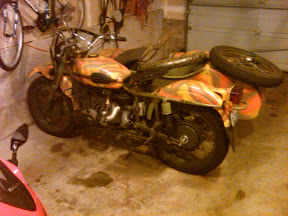It's been a long time, and progress has been slow, but I do have updates.
First, at some point I walked into the garage, took a look at the throttle cable, saw the screw that was holding it in place, and removed it. It turned out to be really easy. I'm not sure how I missed it before.
Also, I've done the calculations (as much as I feel like for now anyway) and bought a drive system. I went with a Hi-Performance AC-50 motor, which comes with the controller and wiring harness. This will give me more power than I should need along with regenerative braking and better performance in hilly terrain (aka home) than a series wound motor would provide.
Now, I'm trying to figure out how to replace the rear wheel with something that has a sprocket so I can figure out the drive ratio and connect the motor directly to the wheel via a chain. This will make it so I can drop the weight of the shaft, use a more space-efficient layout, and avoid hooking a chain to a shaft (which just seems silly). I've asked the folks at the Soviet Steeds forum for help on this front, since I have zero experience in this area.
Tuesday, July 27, 2010
Wednesday, January 6, 2010
Engine Removal
I was not as sick as I thought I was going to be today, so I removed the engine.
Now that the engine is removed, I weighed it again. I'll use this as the base weight so that I can figure out how much it will weigh with various battery/motor combinations. That will be important in estimating available and required torque, and generally figuring out how far and how fast it will go. The total weight was 490lbs (190lbs on the rear tire, 120lbs on the front tire, and 180lbs on the right side tire).
- Get the exhaust out of the way.

From Ural
- Also get rid of the battery, coil, and anything else that might get in the way. While you're at it, put the wheels on 2-3 inch blocks.

From Ural
- Add blocks to support the engine.
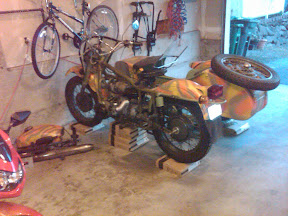
From Ural
- Remove engine mounts. In my case there was also a rubber puck where the transmission interfaced with the shaft drive. I pried that away from the engine.
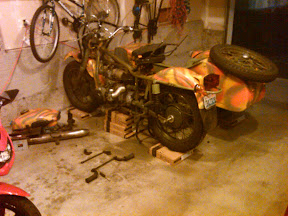
From Ural
- Add blocks to the left of the engine so you have a place to put it.
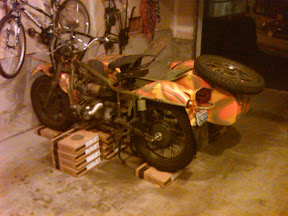
From Ural
- Remove the wheel blocks so that the engine floating free of the frame. Then, heave, push, and pull the engine out onto the blocks to the left. After that, you can put the blocks away.
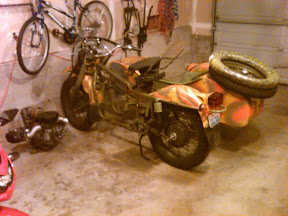
From Ural
Now that the engine is removed, I weighed it again. I'll use this as the base weight so that I can figure out how much it will weigh with various battery/motor combinations. That will be important in estimating available and required torque, and generally figuring out how far and how fast it will go. The total weight was 490lbs (190lbs on the rear tire, 120lbs on the front tire, and 180lbs on the right side tire).
Tuesday, January 5, 2010
Removing the gas tank
I intended to remove the engine today, but only got as far as the gas tank. Still, it's visible progress, which is pretty cool.
Advice for people who want to try it:
- Get a big (maybe 5 gallon) gas can. Mine was only a gallon, so I had to empty it into my car a few times and monitor it closely.
- Get some ventilation. I only opened the garage door after it started getting stinky. It would have been smarter to start with it open.
- Drain the fuel into your gas can. Don't forget to leave the petcock closed until you're ready. Also, it will drain pretty slowly, so try to set it up so that you don't have to hold it.
- Remove the tank. There will probably still be a little gas left, and you'll probably spill some (but not much). Be ready to tip the tank into a position so that it stops leaking once you have it off.
- Drain any remaining fuel into gas can.
e-Ural Project Starting
A while back, I bought a 1963 Ural sidecar motorcycle. I figured that I would enjoy it until it broke down, and then I'd convert it to electric. Well, I didn't even make it home before it broke down, so I had to get it towed the rest of the way, and now I'm starting conversion project.
I should note that I have no particular skills in this area. I don't generally wrench on cars, I don't build little robots, an I'm not an electrical engineer. I write software for a living, and I need hobbies that balance my work. One of those hobbies is learning to play music, and starting today another is converting a motorcycle to electric.
I figured it would be good to figure out how the weight was originally distributed before I start messing with it too much. I understand that weight distribution is very important to how the bike handles, so I'm going to try to keep it reasonably close to the way it is. This might sound intimidating, but I'm pretty sure that this very simple technique works fine to get a rough approximation. All I did was bring my bathroom scale down to the garage, put one wheel on it at a time, and make note of the weights at each wheel. It turned out that ~240lbs fell on the front wheel, ~260lbs fell on the back wheel, and ~160lbs fell on the sidecar wheel, for a total vehicle weight of ~660lbs.
I took the day off from work today because my innards feel like they're moving around inside me, but I'm going to try taking the engine and transmission out, too. I'll let you know how that goes, whether you ask or not.
One last thing though: These projects usually have clever names, so clever name ideas would be appreciated. Such things have been called El Ninja (because it is an electric Ninja), the Electra Cruiser, the KillaCycle (which is the fastest electric motorcycle at 174mph and 7.89s quarter mile), and the Electrocat. Right now, all I've really thought of is eUral and the Silent Sidecar, so please leave suggestions in the comments if you have them.
I should note that I have no particular skills in this area. I don't generally wrench on cars, I don't build little robots, an I'm not an electrical engineer. I write software for a living, and I need hobbies that balance my work. One of those hobbies is learning to play music, and starting today another is converting a motorcycle to electric.
I figured it would be good to figure out how the weight was originally distributed before I start messing with it too much. I understand that weight distribution is very important to how the bike handles, so I'm going to try to keep it reasonably close to the way it is. This might sound intimidating, but I'm pretty sure that this very simple technique works fine to get a rough approximation. All I did was bring my bathroom scale down to the garage, put one wheel on it at a time, and make note of the weights at each wheel. It turned out that ~240lbs fell on the front wheel, ~260lbs fell on the back wheel, and ~160lbs fell on the sidecar wheel, for a total vehicle weight of ~660lbs.
I took the day off from work today because my innards feel like they're moving around inside me, but I'm going to try taking the engine and transmission out, too. I'll let you know how that goes, whether you ask or not.
One last thing though: These projects usually have clever names, so clever name ideas would be appreciated. Such things have been called El Ninja (because it is an electric Ninja), the Electra Cruiser, the KillaCycle (which is the fastest electric motorcycle at 174mph and 7.89s quarter mile), and the Electrocat. Right now, all I've really thought of is eUral and the Silent Sidecar, so please leave suggestions in the comments if you have them.
Subscribe to:
Posts (Atom)
